Menu
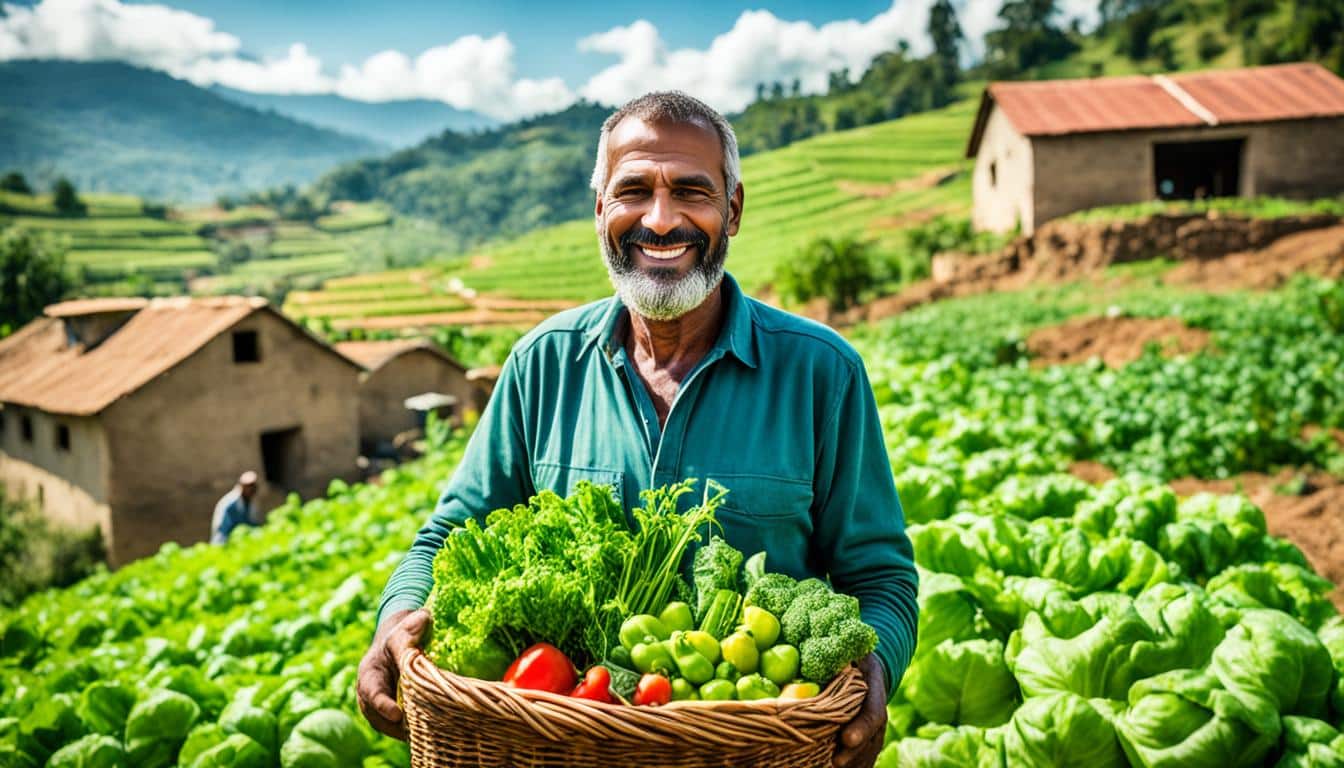
Did you know agriculture is key to Kenya’s economy, directly affecting 26% of its GDP? Another 27% comes indirectly. This shows the big role agriculture plays, mainly small farming, in Kenya’s rural areas. It’s not only about money. For over 70% of the rural people, it means survival. This sector employs more than 40% of Kenya’s total population.
Let’s look at how small farms in Kenya are thriving. They bring in 45% of the government’s money. Plus, they make over 50% of what Kenya earns from selling things abroad. Even with challenges like low prices for black tea, Kenya is the top seller of black tea globally. It also leads in cut flower sales to Europe, making about $1 billion from flowers each year.
Kenya has a lot of farming land, 5.3 million hectares to be exact. This means there’s room for the farming sector to grow. We see small farms doing really well, and these successes show others in Africa what’s possible. This success story isn’t just about changing lives. It’s a model for the future of farming in Kenya.
Smallholder farming in Kenya plays a key role in the country’s economy. Its roots run deep in history, showing how crucial it is for people’s lives. This sector’s growth is influenced by history, geography, and the economy in East Africa.
Smallholder farming in Kenya has a history that goes back before colonial times. It was always a big part of Kenyan culture. Farmers with small plots have shown great adaptability and creativity over the years.
An analysis found that medium-scale farmers, owning between 5-50 hectares, utilised significantly less land for agricultural purposes than they possessed. This demonstrates the evolving land use and ownership dynamics within Kenyan agriculture.
Kenya’s land varies a lot, from rich highlands to dry lowlands. This means different regions grow different crops well. But, in crowded areas, small farms are getting even smaller, which makes farming harder.
Also, when areas get very crowded (about 600-700 people per square kilometre), farming lessens. So, planning how to use the land best is really important for keeping farms productive.
Farming has a big effect on Kenya’s GDP. It gives income to many families and supports other businesses. With the right steps, farming in Kenya can grow, helping to reduce poverty.
If done well, more people living in an area can actually boost farming. But, there’s a limit to how much this helps. It shows that managing land and farming carefully is key to the sector’s success.
Looking at land rules can help Kenya support farmers better. This model is like what helped Asia with the Green Revolution. It aims for growth that’s good for everyone in the long run.
So, it’s vital to find ways to help the sector with targeted efforts. As land becomes scarcer, new ideas are needed to ensure farming’s future in Kenya.
Kenya’s agroecological conditions play a big role in its farming success. The country has many different climate zones and types of soil. It’s important to know how these affect farming in a sustainable way.
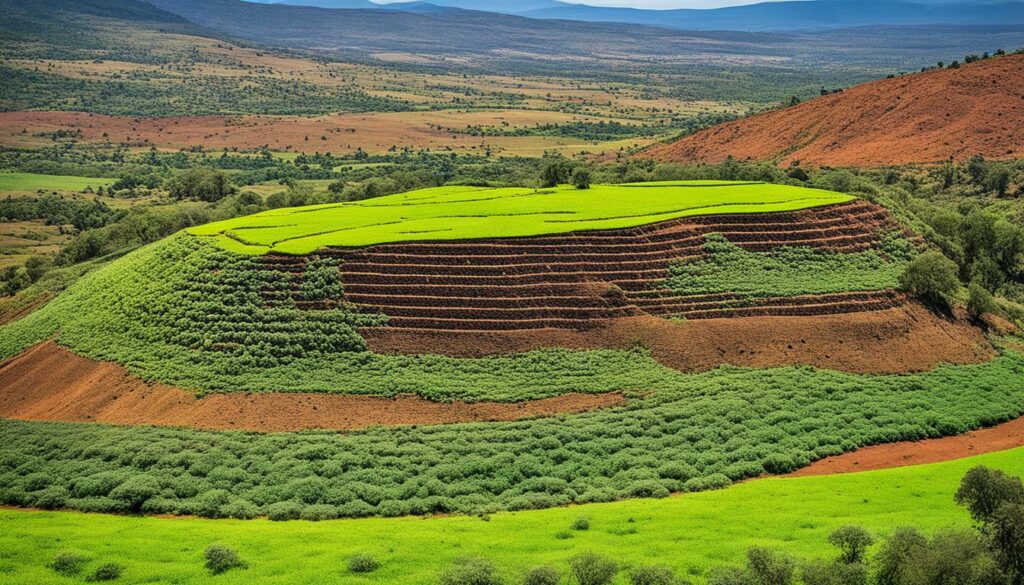
Kenya has different climates, from tropical by the coast to arid further inland. The central highlands get a lot of rain, while other areas are drier and hotter. This affects what can be grown. The soil also changes. The highlands have volcanic soil which is good for crops. But along the coast, sandy soil needs special care.
This variety means farmers need different methods to do well. Ruth Nabaggala has shown this. She used special approaches in Uganda to help farmers earn more. This included looking after the soil and dealing with the climate.
Different parts of Kenya have different farm settings. The highlands are cool and good for growing things like maize and coffee. But the semi-arid areas are more challenging. They often need irrigation and special crops that can survive without much water.
Experts like Charles Tumuhe highlight the need to understand these differences. His work shows that knowing what works in each area can help farmers a lot. For example, training that fits each region can make soil management better.
In some parts of Kenya, such as the coast, the weather and soil make farming hard. Here, using organic fertilisers and changing the crops can help. It shows how important it is to adjust farming to fit the area.
| Region | Main Crops | Key Challenges | Approaches |
|---|---|---|---|
| Highlands | Maize, Tea, Coffee | Soil Erosion | Terracing, Crop Rotation |
| Semi-arid areas | Millet, Sorghum | Drought | Irrigation, Drought-resistant crops |
| Coastal & Western regions | Cashew, Coconut, Mangoes | Sandy Soils, High Humidity | Organic Fertilisation |
In Kenya, it’s key for small farms to be sustainable. They do this by using advanced crop methods, good animal care, and keeping the soil healthy. My talks with students, farm groups, and small farmers have shown the many ways to do this.
Good ways to grow crops are very important for small farms. Techniques like changing crops each season and planting them together help the soil stay fertile. The Krishi Jyoti project boosted harvests by 15.59% to 26.5% with these methods.
Looking after animals well is also big in sustainable farming. Care and selective breeding of animals help farming be more balanced. At the Kenya Institute of Organic Farming (KIOF), combining animals with crops saw good effects, like better soil and more money.
To farm well, the soil needs to be healthy and fertile. Using natural compost and plants that cover the ground keeps the soil full of nutrients. Studies show areas that do this have better soil and more crops.
The following table summarises the impact of various sustainable farming initiatives:
| Initiative | Impact | Example |
|---|---|---|
| Crop Diversity | Increased productivity | Krishi Jyoti Project |
| Livestock Integration | Improved soil fertility | KIOF Experience |
| Soil Health Practices | Enhanced nutrient content | Survey Findings |
Smallholder farming brings big economic benefits, not just to farmers but their communities too. It helps with making money, reaching more markets, and getting financially stronger. This all leads to better living for many people.
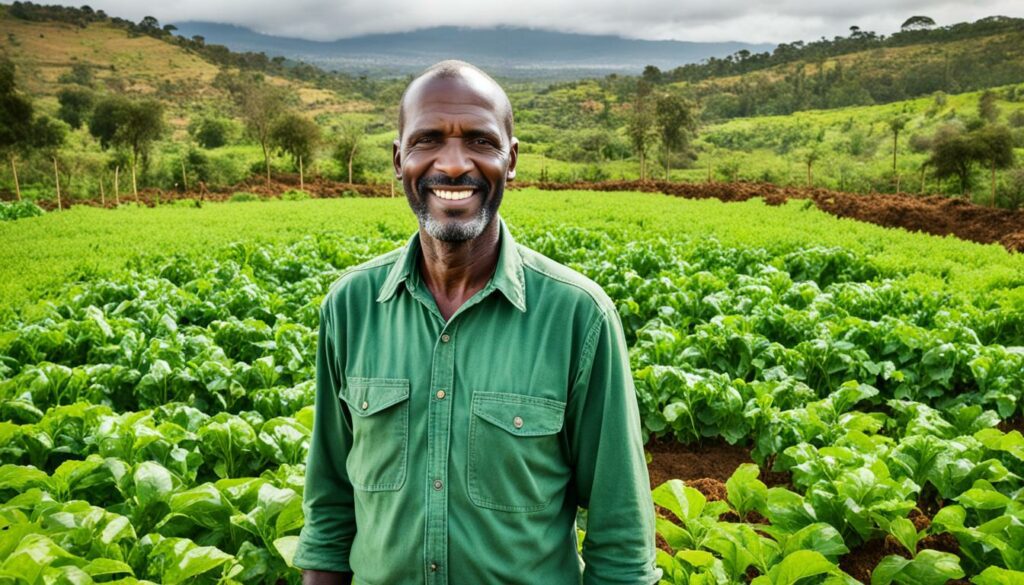
Creating income is crucial in farming. In Kenya, 80% of the countryside’s people depend on farming. Most of these farmers are small. They work hard despite little farming land. They also provide jobs to 70% of the country’s workforce. This boosts incomes across the board.
Access to markets is vital for farmer’s success. In Kenya, 39 projects have helped small farmers get better market info and lower trading costs. This has made it easier for them to sell their products and expand their businesses.
Smallholder farming helps farmers become financially included. By using information that’s specific to them and their farms, they can get more access to money. This helps them invest in better farms and improve farming methods. Studies show that knowing how to use technology to get market info is tied to how well-off they are.
The table below shows the major benefits of smallholder farming:
| Factor | Impact |
|---|---|
| Income Generation | Supports 70% of the national labour force, ensuring steady income sources |
| Market Participation | Over 39 projects facilitating improved market access |
| Financial Empowerment | Enhanced financial inclusion through tailored, location-specific strategies |
Kenyan smallholder farmers are key to the nation’s food. But they face big hurdles in their work. These challenges slow down their farming and harm the environment.
Climate change hits agriculture hard. Small farmers see their crops suffer due to unusual weather, droughts, and unpredictable rains. They must learn to adapt quickly to keep their farms strong.
Getting needed resources is tough for these farmers. They struggle to find good seeds, fertilizers, and water systems. Lack of finances adds to their problems. Small farmers in South Africa’s Limpopo Province share these difficulties. This situation is a global issue, affecting one-third of food producers with little land.
Dealing with pests is a huge issue. Without proper pest control, farmers face crop damage and low output. This problem is seen in many areas, including the US and Kenya. Finding new ways to manage pests is vital for these farmers.
| Region | Challenges | Impact |
|---|---|---|
| Kenya | Climate change, resource access, pest management | Decreased productivity, economic strain |
| Limpopo, South Africa | Economic barriers, high input costs | Hindered agricultural development |
| Florida, USA | Economic fluctuations, market changes | Financial instability for farmers |
| Durban, South Africa | Low incomes due to large-scale farming | Struggle to sustain livelihood |
Solving these challenges in smallholder farming is crucial for growth. It ensures food security and boosts rural communities’ economies. This, in turn, helps society as a whole.
Kenya’s Kerio Valley shows how smallholder farming can be a big success. It has taught us a lot about how hard work, new ideas, and working together can lead to great outcomes. These stories are not just about farming. They show how communities benefit too.
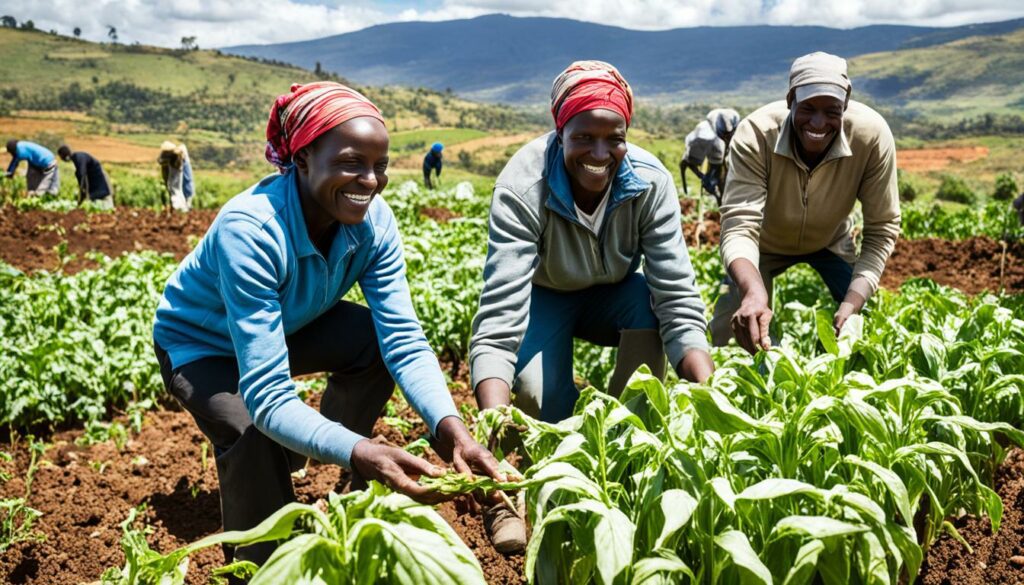
In the Kerio Valley, many small farms were studied. They found a lot of different animals and plants on these farms. Farms run by richer and older people had more types of plants. This means they could offer more varied food.
While the area usually had few types of food, most families could eat well over a week. This is because of the smart farming methods used in the region.
Farming in the Kerio Valley has really helped its people. How well a family did, what language they spoke, and how much they knew, affected how they could eat. The study points out that who makes decisions at home and a family’s background are key to eating well.
This shows how farming in Kenya, especially in places like the Kerio Valley, can bring good changes. When farming fits with the local community and ways, everyone benefits.
We’ve learned a lot from how farming works in the Kerio Valley. Making small farms work involves many things, like caring for nature and working with others. Having different things on the farm and selling some food are important too.
Technology and financial help, like the Kilimo Booster loan, can also be a big support. They help farmers deal with tough times.
The Kerio Valley is proof that small farms in Kenya can mean big things. By sharing stories of success, we can encourage more people to farm this way. This can lead to better lives and a healthier planet.
In Kenya, farming is changing for the better, thanks to new ideas and technology. Small farmers are seeing more productivity and are helping Kenya lead in Africa’s farming progress.
Technology is playing a key role in helping Kenyan farmers do better. For example, Musoni Kenya started in 2010 and has now 21 branches. They have given many loans to farmers, showing how financial help impacts farming.
Working with the Grameen Foundation, Musoni offers digital loans. This Kilimo Booster loan helps farmers manage their money better.
Kenya’s government is also big on supporting farming. They know it helps the economy and cuts poverty. They do things like bring farmers and researchers together and focus on practical solutions from research.
Global groups are also joining in to boost Kenya’s farming. Projects like Feed the Future have been a great help. They’re making sure tech and progress reach even the smallest farmers.
They’ve also set up places where different people can talk and come up with new ways to help farming. Over 25 million people are joining in, showing a big push for better farming together.
Kenya’s efforts in farming go beyond just growing food. They also aim for wider benefits in rural places. This approach looks to solve problems and make communities stronger.
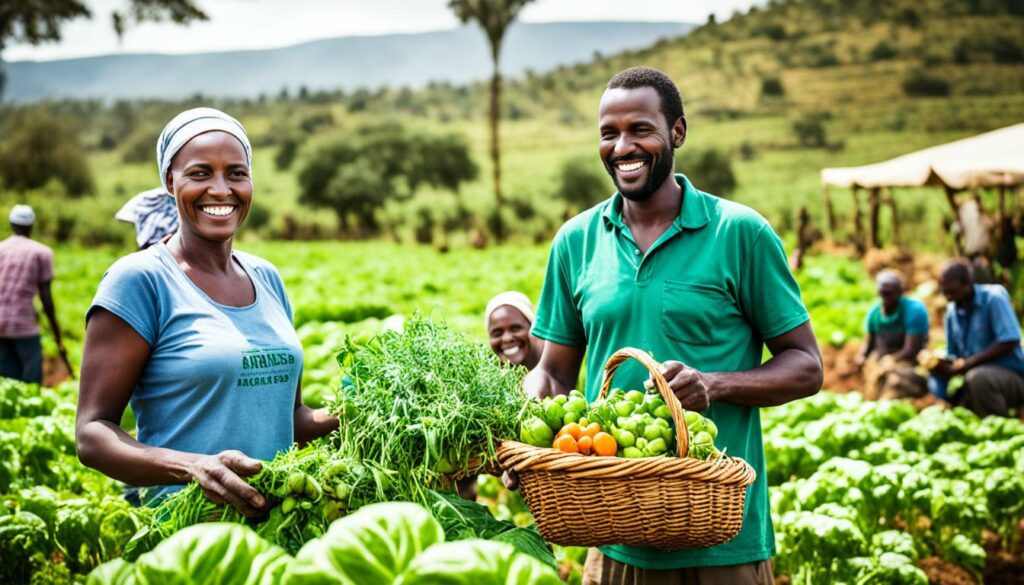
There are about 12 million Kenyans living in areas that need help. The project supports 50,000 farmers in growing coffee and tea. It trains over 54,000 people to improve farming and fight off bad farming conditions.
The overarching aim is to improve the livelihoods of 30,000 smallholder farmers in Kenya through sustainable agricultural practices, ultimately leading to self-sufficiency in agriculture.
The farming project also boosts local areas. It works with tea and coffee groups in Kirinyaga County. It also includes 1,000 people from groups looking after forests and water. This helps bring back nature and make the economy stronger.
Partners like The IKEA Foundation and others are a big help. They make sure the plan helps lots of people and has what it needs.
Vi Agroforestry is helping 35,000 hectares of land and training farmers. They made great progress planting 1.3 million trees. This has started to make farming more sustainable.
The Livelihoods Carbon Fund works to remove a lot of CO2 over 10 years. It’s got money from the Livelihoods Fund and Brookside Dairy. This support makes sure projects can keep helping for a long time.
Finally, these projects help meet the Bonn Challenge’s goal. This is to fix 150 million hectares of land by 2020. They’re a big step towards making food better and communities stronger in Kenya.
In Kenya, women play a big role in smallholder farming. They make up 70% of those who grow and provide food. Their work is key to the country’s farming but they meet a lot of challenges. These challenges are often because of their gender, stopping them from reaching their full potential.
Many rural women in Kenya earn money from selling small livestock. The Food and Agriculture Organization (FAO) says over 1.7 billion people depend on livestock. In Kenya, women mostly look after the livestock, showing their big role in farming.
Their work is essential. Yet, many problems specific to women make their jobs harder. A big issue is access to CCPP vaccines for their animals. Many things, like not enough cold storage, late services, and not enough money, stop these women from vaccinating their animals on time. This situation is dangerous because CCPP can kill up to 70% of sick animals. Even though Kenya makes vaccines that work really well, these vaccines don’t always get to the women. Women also have trouble getting direct help and training to deal with livestock diseases without a man’s help.
Because of these challenges, there are programmes to help empower women in agriculture. These programmes focus on giving women better access to vaccines, timely information, and training. By empowering women in small farming, there can be more productivity and sustainable growth. This will lead to an overall boost in the economy and make rural communities stronger.
Climate change is a big threat to Kenyan smallholder farmers. Most, like 88.3%, say they get less rain now. And 79.1% complain that rain doesn’t come when needed.
What’s more, about 76.6% feel the weather getting hotter. This makes farming even harder for them.
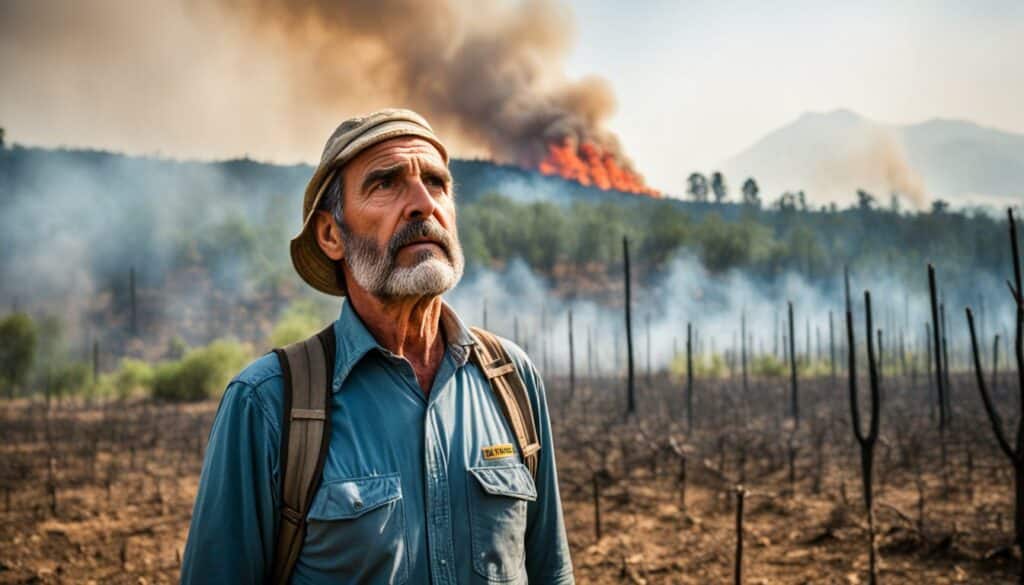
Farming means a lot for Kenya, with over half its economy tied to it. It also boosts the GDP and makes up two-thirds of exports. But, climate change is putting this at risk.
Nearly all small farmers know they need to cope with these changes better. They are looking for new ways to be strong against the effects of climate change.
About 46% of these farmers are already changing how they farm. They’re planting trees to fight off the worst and keep their farms safe. Others are using what’s called climate-smart agriculture.
This kind of farming helps produce more food, is tougher against bad weather, and cuts down on harmful gases. It’s really helpful to fight the effects of climate change in farming.
More than 80% of Kenya’s rural folks depend on farming for their living. Making farms better at handling climate change is very important. It’s because the way we farm is a big part of what hurts the planet.
This is also urgent because the world needs to cut back on greenhouse gases. And we need to do our best to keep our farms safe from climate change.
For Kenyan farmers, who already face many challenges, this support is critical. They need help to deal with poverty, lack of good roads, and not enough new technology.
Farmers choose how to tackle climate change based on lots of things. Like where they are, what resources they have, and if they have help from the government. Using the best, proven methods can help keep farming in Kenya strong for the future.
In Kenya, smallholder farmers are changing the game. They are using new methods to farm well. These methods lead to better crops and more money for the farmers.
A big program in Kenya helped around 28,000 farmers in 2011. Since then, almost half a million farmers joined in. This shows how helpful these farming methods are.
Farmers use clever ways to deal with climate issues. They also try new things to improve their crops. This makes their farms more successful and better for the future.
In Rwanda, farmers are using phones to get farming help. This has made a big difference in the amount of crops they grow. Also, there’s a plan to help farmers cope with changing climates better over the next 10 years.
The stories also talk about how farming helps the economy. Women farmers are a big part of this success story. By investing in their farms and homes, they make everyone in their area richer.
By 2030, the effort hopes to help provide more food and money to farmers. This shows their big goal to help farming communities for a long time.
Getting involved in markets can lead to better earnings and lasting jobs for small-scale farmers. It’s key to know about both local market participation and international market access. This helps make the most of agricultural market dynamics and spot trade opportunities for smallholders.
Being part of local markets is crucial for small farmers. Those near cities tend to sell more than rural ones. The key reason is the short distance to their buyers, a big hurdle for rural farming. They sell more if they get good prices and know what the market is like.
In Kenya, most farms are small, under five acres. This makes it hard to use the latest technology, which affects how much they can take part in markets.
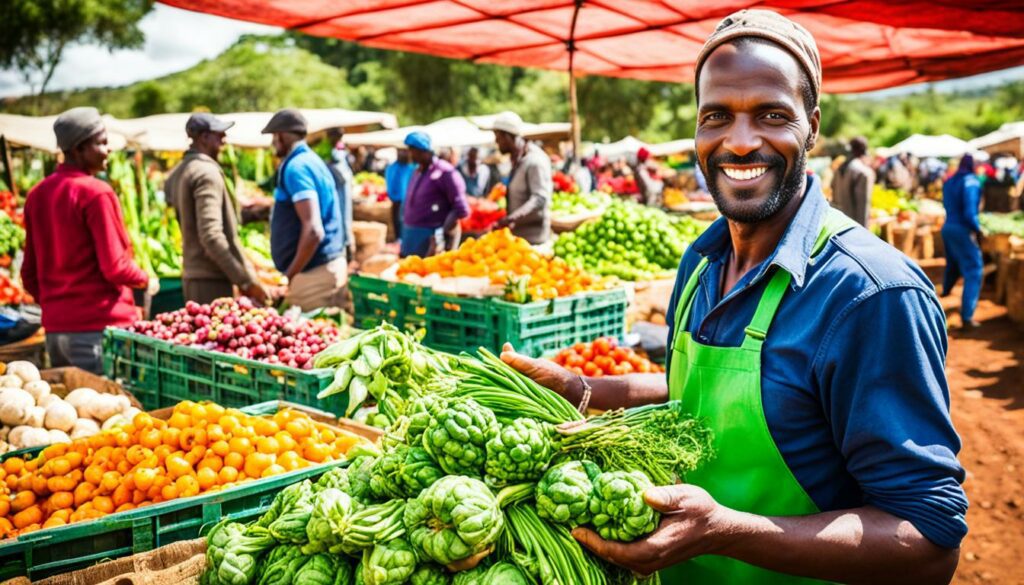
Looking at markets abroad can bring big chances for small farmers. Selling overseas opens up a larger market. But it’s not easy, with tough quality rules and shipping issues to beat.
Groups that help connect farmers to global markets are a big help. They make it easier to handle these challenges. Taking advantage of these trade opportunities for smallholders is key for their growth and future.
In Kenya, government policies are vital for smallholder farmers. They help with necessary things like subsidies, money support, and building better roads in the countryside. All these efforts are to make sure farming grows and stays strong over time.
Subsidies and loans help small farmers a lot. They give farmers the chance to buy good seeds, fertilisers, or new farming tools. For instance, in 2010, Musoni Kenya started to help. By July 2017, they had given out over 200,000 loans to help more than 90,000 people. This shows how important it is to have special money help for farmers and to keep this help coming to improve farming.
Building better paths, water systems, and places to keep crops helps farmers a great deal. These make it easier to farm well and reach markets where they can sell their products. Grameen Foundation and Musoni work together to use new tech and make getting money for farming easier. They made the Kilimo Booster loan to match farmers’ payment times, helping them a lot.
Working with big international groups, like Feed the Future Partnering for Innovation backed by USAID, shows the government wants to spread new farming ideas and improve how farmers sell their goods. These big plans aim to help more farmers and reduce the big difference in money between men and women farmers. About 11% of farmers feel strong and this gap in money is at 23%. This makes it clear that using thoughtful and targeted laws is key to keep helping small farmers succeed.
Smallholder farming in Kenya has a long and rich history. It has always been a key part of rural life. This form of farming boosts the economy by adding to the GDP.
Kenya’s varied geography means different regions have their own weather and soil. This affects what crops can be grown. It helps the country have a wide range of agricultural products.
Small farmers are a big part of Kenya’s economy. They help many people in rural areas make a living. Their work also grows the economy in a sustainable way.
Kenya’s diverse climates and soils mean farming practices differ across the country. Farmers have to choose crops and methods that suit their area. This is key to successful farming in Kenya.
In Kenya, farmers use smart planting methods and care for their animals well. They also look after the soil to keep it fertile. These steps help their farms be successful over time.
Small farmers earn money and find new markets for their products. This helps improve their lives and those of the people around them.
Climate change and limited resources are tough challenges for small farmers in Kenya. They also have to deal with pest and disease management. These hurdles affect how much they can produce and how long they can keep farming.
Kerio Valley is a great example of how small farms can lead to big community benefits. It shows that using sustainable methods and working together makes a real difference.
Innovation is key to making small farms in Kenya more successful. New technologies and support from local and global groups help farmers do better and be more sustainable.
Farming on a small scale in Kenya brings food security to local areas. It also boosts the economy and helps farmers work together towards common goals.
Women are very important in small farming but they face challenges not seen by men. It’s crucial to support programmes that help them. This ensures that farming is fair, productive, and sustainable.
Kenya’s small farmers are finding ways to cope with the changing climate. They use new farming methods to protect their crops. This keeps their livelihoods safe.
There are many stories of farmers in Kenya doing well with smart, sustainable farming. These examples show how good farming practices can change lives for the better.
Small farmers in Kenya can find success in both local and global markets. Knowing how to navigate these markets is essential. It can lead to more money and a stronger business.
The Kenyan government helps small farmers with financial aid, policies, and improving infrastructure. These support their growth and success, making farming a viable occupation.